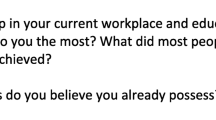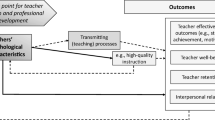Abstract
In this paper, we investigate leadership related to the instruction of lower division undergraduate courses at five university mathematics departments with strong calculus programs. We use social network analysis to identify patterns of influence on instruction, using the relations: advice seeking, instructional material sharing, discussion of instructional matters, and explicit influence on teaching approach. Data were gathered through social network surveys, which received over 60% response rate at each site. Considering both formal and informal phenomena, we identify variation in vertical and distributed instructional leadership structures within these departments. In these five communities, not all those with hierarchical authority have real influence over instructional practice, but those with the most influence over instruction do hold formally recognized positions. In light of these findings, we discuss implications for future research and practice in higher education.





Similar content being viewed by others

References
Adler, P. S., & Kwon, S.-W. (2002). Social capital: prospects for a new concept. The Academy of Management Review, 27(1), 17–40.
Andrews, T. C., Conaway, E. P., Zhao, J., & Dolan, E. L. (2016). Colleagues as change agents: How department networks and opinion leaders influence teaching at a single research university. Cell Biology Education, 15(2), ar15–ar15. https://doi.org/10.1187/cbe.15-08-0170.
Apkarian, N., & Kirin, D. (2017). Progress through calculus: census survey technical report. Mathematical Association of America. http://bit.ly/PtC_Reporting
Aragón, O. R., Eddy, S. L., & Graham, M. J. (2018). Faculty beliefs about intelligence are related to the adoption of active-learning practices. CBE Life Sciences Education, 17(ar47), 1–9.
Borgatti, S. P., Everett, M. G., & Johnson, J. C. (2013). Analyzing social networks. SAGE.
Braun, V., & Clarke, V. (2006). Using thematic analysis in psychology. Qualitative Research in Psychology, 3(2), 77–101.
Bressoud, D., Mesa, V., & Rasmussen, C. (Eds.). (2015). Insights and recommendations from the MAA national study of college calculus. MAA Press.
Bressoud, D., & Rasmussen, C. (2015). Seven characteristics of successful calculus programs. Notices of the American Mathematical Society, 62(2), 144–146.
Bridwell-Mitchell, E. N., & Cooc, N. (2016). The ties that bind: how social capital is forged and forfeited in teacher communities. Educational Researcher, 45(1), 7–17.
Brown, J. S., & Duguid, P. (1991). Organizational learning and communities-of-practice: toward a unified view of working, learning, and innovation. Organization Science, 2(1), 40–57.
Bryman, A. (2007). Effective leadership in higher education: a literature review. Studies in Higher Education, 32(6), 693–710. https://doi.org/10.1080/03075070701685114.
Carter, D. R., DeChurch, L. A., Braun, M. T., & Contractor, N. S. (2015). Social network approaches to leadership: an integrative conceptual review. Journal of Applied Psychology, 100(3), 597–622. https://doi.org/10.1037/a0038922.
Coburn, C. E., & Russell, J. L. (2008). District policy and teachers’ social networks. Educational Evaluation and Policy Analysis, 30(3), 203–235.
Cole, R. P., & Weinbaum, E. H. (2010). Changes in attitude: peer influence in high school reform. In A. J. Daly (Ed.), Social network theory and educational change (pp. 77–95). Harvard Education Press.
Daly, A. J. (2010) (Ed.). Social network theory and educational change. Harvard Education Press.
Daly, A. J., Der-Martirosian, C., Moolenaar, N. M., & Liou, Y.-H. (2014). Accessing capital resources: investigating the effects of teacher human and social capital on student achievement. Teachers College Record, 116(7).
DeRue, D. S., & Ashford, S. J. (2010). Who will lead and who will follow? A social process of leadership identity and construction in organizations. The Academy of Management Review, 35(4), 627–647.
Devos, G., Tuytens, M., & Hulpia, H. (2014). Teachers’ organizational commitment: examining the mediating effects of distributed leadership. American Journal of Education, 120(2), 205–231.
Forman, E. A. (2003). A sociocultural approach to mathematics reform: speaking, inscribing, and doing mathematics within communities of practice. In J. Kilpatrick, W. G. Martin, & D. Schifter (Eds.), A research companion to principles and standards for school mathematics (pp. 333–352). NCTM.
Freeman, L. C. (2004). The development of social network analysis: a study in the sociology of science. Empirical Press ; BookSurge.
Gaubatz, J. A., & Ensminger, D. C. (2017). Department chairs as change agents: leading change in resistant environments. Educational Management Administration & Leadership, 45(1), 141–163. https://doi.org/10.1177/1741143215587307.
Gess-Newsome, J., Southerland, S. A., Johnston, A., & Woodbury, S. (2003). Educational reform, personal practical theories, and dissatisfaction: the anatomy of change in college science teaching. American Educational Research Journal, 40(3), 731–767. https://doi.org/10.3102/00028312040003731.
Gibbons, R. E., Villafañe, S. M., Stains, M., Murphy, K. L., & Raker, J. R. (2018). Beliefs about learning and enacted instructional practices: an investigation in postsecondary chemistry education. Journal of Research in Science Teaching, 55(8), 1111–1133. https://doi.org/10.1002/tea.21444.
Henderson, C., & Dancy, M. H. (2007). Barriers to the use of research-based instructional strategies: the influence of both individual and situational characteristics. Physical Review Special Topics - Physics Education Research, 3(2), 1–14. https://doi.org/10.1103/PhysRevSTPER.3.020102.
Kadushin, C. (2011). Understanding social networks: theories, concepts, and findings (1 edition). Oxford University Press.
Kezar, A. (2014). Higher education change and social networks: a review of research. The Journal of Higher Education, 85(1), 91–125. https://doi.org/10.1353/jhe.2014.0003.
Knaub, A. V., Henderson, C., & Fisher, K. Q. (2018). Finding the leaders: an examination of social network analysis and leadership identification in STEM education change. International Journal of STEM Education, 5(1), 26. https://doi.org/10.1186/s40594-018-0124-5.
Koch, A. K. (2017). It’s about the gateway courses: defining and contextualizing the issue. New Directions for Higher Education, 2017(180), 11–17. https://doi.org/10.1002/he.20257.
Landrum, R. E., Viskupic, K., Shadle, S. E., & Bullock, D. (2017). Assessing the STEM landscape: the current instructional climate survey and the evidence-based instructional practices adoption scale. International Journal of STEM Education, 4(1). https://doi.org/10.1186/s40594-017-0092-1.
Lin, N. (2002). Social capital: a theory of social structure and action. Cambridge University Press.
Lund, T. J., & Stains, M. (2015). The importance of context: an exploration of factors influencing the adoption of student-centered teaching among chemistry, biology, and physics faculty. International Journal of STEM Education, 2(1), 13. https://doi.org/10.1186/s40594-015-0026-8.
Ma, S., Herman, G. L., Tomkin, J. H., Mestre, J. P., & West, M. (2018). Spreading teaching innovations in social networks: the bridging role of mentors. Journal for STEM Education Research, 1(1–2), 60–84. https://doi.org/10.1007/s41979-018-0002-6.
Ma, S., Herman, G. L., West, M., Tomkin, J., & Mestre, J. (2019). Studying STEM faculty communities of practice through social network analysis. The Journal of Higher Education, 90(5), 773–799. https://doi.org/10.1080/00221546.2018.1557100.
Mathison, S. (1988). Why triangulate? Educational Researcher, 17(13), 13–17.
McPherson, M., Smith-Lovin, L., & Cook, J. M. (2001). Birds of a feather: homophily in social networks. Annual Review of Sociology, 27, 415–444.
Middleton, J. A., Krause, S., Beeley, K., Judson, E., Ernzen, J., & Culbertson, R. (2015). Examining the relationship between faculty teaching practice and interconnectivity in a social network. IEEE Frontiers in Education Conference (FIE), 2015, 1–7. https://doi.org/10.1109/FIE.2015.7344179.
NASEM. (2016). Barriers and opportunities for 2-year and 4-year STEM degrees: systemic change to support students’ diverse pathways. National Academies of Sciences, Engineering, and Medicine; The National Academies Press. https://doi.org/10.17226/21739.
NRC. (1999). Transforming undergraduate education in science, mathematics, engineering, and technology. National Research Council; National Academy Press.
Ogawa, R. T., & Bossert, S. T. (1995). Leadership as an organizational quality. Educational Administration Quarterly, 31(2), 224–243.
Otte, E., & Rousseau, R. (2002). Social network analysis: a powerful strategy, also for the information sciences. Journal of Information Science, 28(6), 441–453. https://doi.org/10.1177/016555150202800601.
PCAST. (2012). Engage to excel: producing one million additional college graduates with degrees in science, technology, engineering, and mathematics. In President’s Council of Advisors on Science and Technology. Office of Science and Technology: Policy.
Penuel, W. R., Frank, K. A., & Krause, A. (2010). Between leaders and teachers: using social network analysis to examine the effects of distributed leadership. In A. J. Daly (Ed.), Social network theory and educational change (pp. 159–178). Harvard Education Press.
Penuel, W. R., Sun, M., Frank, K. A., & Gallagher, H. A. (2012). Using social network analysis to study how collegial interactions can augment teacher learning from external professional development. American Journal of Education, 119(1), 103–136. https://doi.org/10.1086/667756.
Quardokus Fisher, K., & Apkarian, N. (2018). Instructor discussion networks across 22 STEM departments. In C. Henderson, C. Rasmussen, A. V. Knaub, N. Apkarian, K. Quardokus Fisher, & A. J. Daly (Eds.), Researching and enacting change in postsecondary education: leveraging instructors’ social networks (pp. 96–125). Routledge.
Quardokus Fisher, K., & Henderson, C. (2015). Promoting instructional change: using social network analysis to understand the informal structure of academic departments. Higher Education, 70(3), 315–335. https://doi.org/10.1007/s10734-014-9831-0.
Rasmussen, C., Apkarian, N., Hagman, J. E., Johnson, E., Larsen, S., Bressoud, D., & Progress through Calculus Team. (2019). Characteristics of Precalculus through Calculus 2 programs: insights from a national census survey. Journal for Research in Mathematics Education, 50(1), 98–112.
Rasmussen, C., & Ellis, J. (2015). Calculus coordination at PhD-granting universities: more than just using the same syllabus, textbook, and final exam. In D. Bressoud, V. Mesa, & C. Rasmussen (Eds.), Insights and recommendations from the MAA national study of college calculus (pp. 111–120). MAA Press.
Rasmussen, C., Ellis, J., Zazkis, D., & Bressoud, D. (2014). Features of successful calculus programs at five doctoral degree granting institutions. In S. Oesterle, P. Liljedahl, C. Nicol, & D. Allan (Eds.), Proceedings of the 38th Conference of the International Group for Psychology of Mathematics Education and the 36th Conference of the North American Chapter of the Psychology of Mathematics Education (Vol. 5, pp. 33–40). PME.
Rocard, M. (2007). Science education NOW: a renewed pedagogy for the future of Europe. European Comission. https://ec.europa.eu/research/science-society/document_library/pdf_06/report-rocard-on-science-education_en.pdf
Schein, E. H. (2010). Organizational culture and leadership (4th ed.). Jossey-Bass.
Scott, J. (2012). Social network analysis (3rd ed.). SAGE Publications Ltd..
Skvoretz, J., Risien, J., & Goldberg, B. B. (2019). Network measurement and data collection methods in higher education: practices and gudelines. In C. Henderson, C. Rasmussen, A. V. Knaub, N. Apkarian, K. Quardokus Fisher, & A. J. Daly (Eds.), Researching and enacting change in postsecondary education: leveraging instructors’ social networks (pp. 74–95). Routledge.
Spalter-Roth, R., Mayorova, O., Scelza, J., & Van Nooren, N. (2010). Teaching alone? Sociology faculty and the availability of social networks. American Sociological Association.
Spillane, J. P. (2006). Distributed leadership (1st ed). Jossey-Bass.
Thornton, K., Walton, J., Wilson, M., & Jones, L. (2018). Middle leadership roles in universities: Holy Grail or poisoned chalice. Journal of Higher Education Policy and Management, 40(3), 208–223. https://doi.org/10.1080/1360080X.2018.1462435.
van Ameijde, J. D. J., Nelson, P. C., Billsberry, J., & van Meurs, N. (2009). Improving leadership in higher education institutions: a distributed perspective. Higher Education, 58(6), 763–779.
Wasserman, S., & Faust, K. (1994). Social network analysis: methods and applications. Cambridge University Press.
Wenger, E. (1998). Communities of practice: learning, meaning, and identity. Cambridge University Press.
Yukl, G. (2012). Effective leadership behavior: what we know and what questions need more attention. Academy of Management Perspectives, 26(4), 66–85. https://doi.org/10.5465/amp.2012.0088.
Funding
This material is based in part upon work funded by the National Science Foundation under Grant Nos. 0910240 and 1430540.
Author information
Authors and Affiliations
Corresponding author
Additional information
Publisher’s note
Springer Nature remains neutral with regard to jurisdictional claims in published maps and institutional affiliations.
Electronic supplementary material
ESM 1
(DOCX 1266 kb)
Rights and permissions
About this article
Cite this article
Apkarian, N., Rasmussen, C. Instructional leadership structures across five university departments. High Educ 81, 865–887 (2021). https://doi.org/10.1007/s10734-020-00583-6
Published:
Issue Date:
DOI: https://doi.org/10.1007/s10734-020-00583-6



